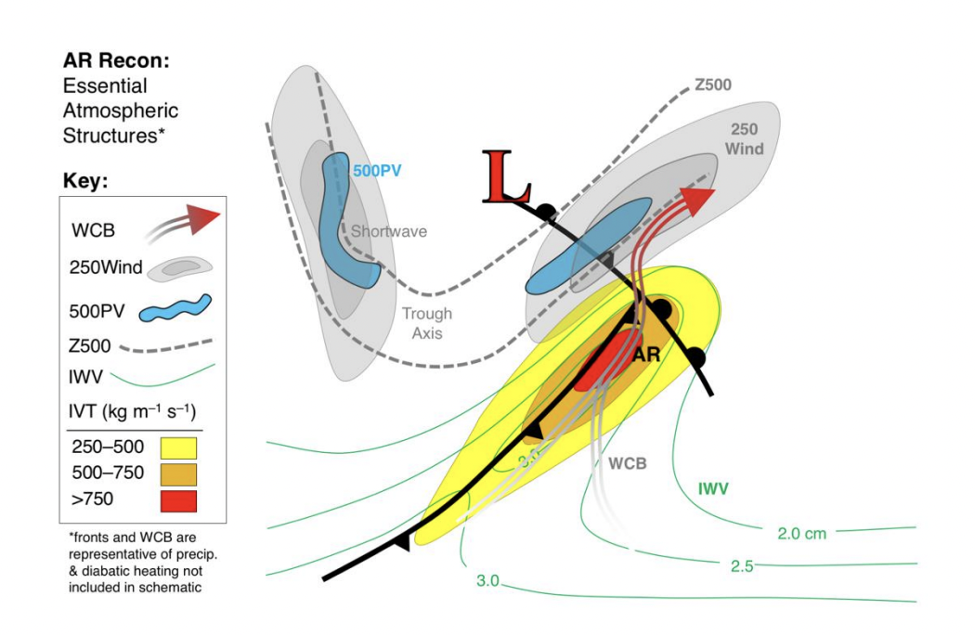CW3E Publication Notice
Atmospheric River Reconnaissance Workshop Promotes Research and Operations Partnership
January 12, 2022
Anna M. Wilson, along with co-authors Alison Cobb, F. Martin Ralph, Luca Delle Monache, Forest Cannon, Chad Hecht, and Minghua Zheng (Center for Western Weather and Water Extremes, Scripps Institution of Oceanography), Vijay Tallapragada (NOAA/NWS/NCEP/Environmental Modeling Center), Chris Davis (National Center for Atmospheric Research), James Doyle and Carolyn Reynolds (U.S. Naval Research Laboratory), Florian Pappenberger and David Lavers (European Centre for Medium-Range Weather Forecasts), Aneesh Subramanian (University of Colorado, Boulder), Jason Cordeira (Plymouth State University), and Jonathan Rutz (NOAA/NWS/Western Region Headquarters) recently published a paper in Bulletin of the American Meteorological Society. The article, titled “Atmospheric River Reconnaissance Workshop Promotes Research and Operations Partnership”, contributes to the goals of CW3E’s 2019-2024 Strategic Plan to support Atmospheric River (AR) Research and Applications by highlighting the Atmospheric River Reconnaissance (AR Recon) Workshop and its role in promoting research and operations partnerships.
This article presents a summary of the 2021 AR Recon Workshop, a virtual event that brought together AR Recon’s diverse stakeholders to convene several discussions, with the goals of 1) sharing the results of AR Recon data 2) coordinating and inspiring future work on data collection, assimilation, metric development, and impact assessment, and 3) to strengthen the Research and Operations Partnership (RAOP) approach being developed by AR Recon. As Wilson et al. discuss throughout the article, AR Recon observations fill critical gaps in the traditional observation system, enabling advances in the understanding of physical processes that modulate AR characteristics. The 2021 AR Recon Workshop provided a specific opportunity for the group to take time to highlight both accomplishments and lessons learned from the prior season, prepare for the next season, share key results from data impact studies, and develop coordinated case study approaches. The workshop also enabled discussions about the future, the exploration of collaborative opportunities to learn more about the physical processes, and refinements in targeting strategies aimed at improving the representation of atmospheric initial conditions in operational NWP models. Scientific discussion ranged between topics including 2021 AR Recon observations, available forecasting tools, essential atmospheric structures (Figure 1), and impacts of AR Recon data on forecasts.
The outcomes of the AR Recon Workshop highlighted by Wilson et al. showcase the program’s role as a successful RAOP, bringing diverse stakeholders together, developing opportunities for collaborative research partnerships, improving forecast accuracy for the U.S. West Coast, and providing a case study for further application.
Figure 1: Schematic of physical targets for AR Recon.
Wilson, A. M., Cobb, A., Ralph, F. M., Tallapragada, V., Davis, C., Doyle, J., Delle Monache, L., Pappenberger, F., Reynolds, C., Subramanian, A., Cannon, F., Cordeira, J., Haase, J., Hecht, C., Lavers, D., Rutz, J. J., & Zheng, M. (2021). Atmospheric River Reconnaissance Workshop Promotes Research and Operations Partnership, Bulletin of the American Meteorological Society (published online ahead of print), https://doi.org/10.1175/BAMS-D-21-0259.1

